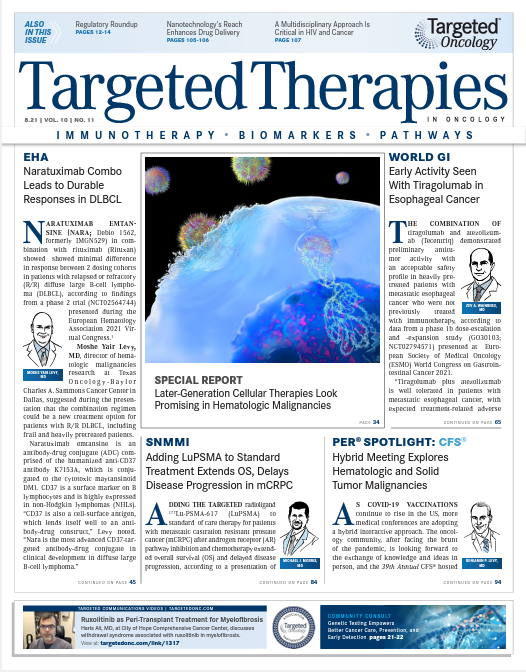T-Cell–Inflamed Gene Expression and High Neoantigen Load May Correlate With Improved Survival in Neuroblastoma
The immune biology of the neuroblastoma microenvironment is an emerging field.

Children with high-risk neuroblastoma who harbor a T-cell-inflamed signature show improved overall survival (OS) vs those with non–T-cell–inflamed tumors (P < .05) independent of MYCN amplification status, according to results evaluating patients in 2 cohorts: the discovery cohort (n = 123) and the validation cohort (n = 48).1 Investigators measured the prognostic strength of T-cell–inflamed gene expression and neoantigen load in these cohorts. Further, they compared transcriptional programs on T-cell–inflamed and non–T-cell–inflamed high-risk neuroblastomas to determine possible mechanisms of immune exclusion.
In addition to seeing a benefit in OS, investigators also noted that higher neoantigen load was associated with better event-free survival (EFS) and OS (P < .005), according to the findings published in the Journal for ImmunoTherapy of Cancer. Active MYCN, ASCL1, SOX11, and KMT2A transcriptional programs were inversely correlated with the T-cell–inflamed signatures for both cohorts.
The immune biology of the neuroblastoma microenvironment is an emerging field. This study evaluated how immunogenomic determinants influence neuroblastoma phenotype by analyzing the correlation between patient survival, T-cell–inflamed gene expression phenotype, and neoantigen tumor load. Findings suggest that these biomarkers are prognostic in high-risk neuroblastoma. Further, the investigators identified tumor-intrinsic signaling pathways that are active in neuroblastomas with a non–T-cell-inflamed phenotype.
The discovery cohort was comprised of patients in the Therapeutically Applicable Research to Generate Effective Treatments (or, TARGET) program and the validation cohort was made up of patients in the Gabriella Miller Kids First program. Tumors identified in the discovery cohort were categorized into 3 groups: T-cell inflamed, non–T-cell inflamed, and intermediate.
In the study, the investigators wrote that EFS and OS were analyzed according to the level of expression of the T-cell–inflamed signature in 118 high-risk patients in the discovery cohort. They noted that patients with T-cell–inflamed tumors had significantly better OS vs those with non–T-cell–inflamed tumors (HR, 0.56; P = .043; TABLE).1 A similar trend was observed in EFS, but the results did not reach statistical significance (HR, 0.69; P = .17). Similar to other high-risk cohorts, MYCN status was not statistically significantly associated with OS or EFS (OS: P = .38; EFS: P = .58).
Cox proportional hazards models were used to test the association between the tumor group and the survival outcome (EFS and OS) in the discovery and validation cohorts.
The T-cell–inflamed tumor group and the intermediate group in the discovery cohort showed similar probabilities of survival. As a result, the investigators combined these 2 groups and compared the probability of survival to patients with non–T-cell–inflamed tumors (OS: P = .0076, EFS: P = .10). In the high risk patients, similar associations between T-cell–inflamed and intermediate tumors and improved survival were also observed. No significant association with survival outcome was detected for age, MYCN status, or ploidy.
The presence of effector T cells in the tumor microenvironment has been associated with improved survival in adults with many types of cancer. T-cell–inflamed tumors are characterized by type I interferon activation, immune-potentiating chemokines, antigen presentation, cytotoxic effector molecules, and activated CD8+ T cells. Other known predictors of response to immunotherapy include a high tumor mutational burden and a high neoantigen load. In contrast, resistance to immunotherapy has been correlated with tumors that lack the T-cell-inflamed signature.1
These results suggest that T-cell–inflamed gene expression and high neoantigen load may independently affect the clinical behavior of neuroblastoma tumors and can result in improved survival. The authors noted that a greater understanding of the molecular mechanisms that drive the presence or absence of T-cell infiltration and neoantigen load could lead to better personalized treatment approaches and provide insight into the development of new therapies. The investigators concluded that further clinical research that evaluates the efficacy of modalities of immunotherapy in patients with neuroblastoma tumors that are T-cell inflamed or harbor high neoantigen load is warranted.
REFERENCE:
Bao R, Spranger S, Hernandez K, et al. Immunogenomic determinants of tumor microenvironment correlate with superior survival in high-risk neuroblastoma. J Immunother Cancer. 2021;9(7):e002417. doi:10.1136/jitc-2021-002417
